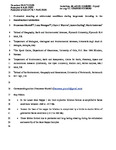Protracted Shearing at Midcrustal Conditions During Large‐Scale Thrusting in the Scandinavian Caledonides
| dc.contributor.author | Giuntoli, F | |
| dc.contributor.author | Menegon, Luca | |
| dc.contributor.author | Warren, CJ | |
| dc.contributor.author | Darling, J | |
| dc.contributor.author | Anderson, Mark | |
| dc.date.accessioned | 2020-09-01T13:07:04Z | |
| dc.date.available | 2020-09-01T13:07:04Z | |
| dc.date.issued | 2020-09 | |
| dc.identifier.issn | 0278-7407 | |
| dc.identifier.issn | 1944-9194 | |
| dc.identifier.other | ARTN e2020TC006267 | |
| dc.identifier.uri | http://hdl.handle.net/10026.1/16206 | |
| dc.description.abstract |
<jats:title>Abstract</jats:title><jats:p>During continental collision, large tracts of crust are mobilized along major shear zones. The metamorphic conditions at which these zones operate, the duration of thrusting, and the deformation processes that facilitated hundreds of km of tectonic transport are still unclear. In the Scandinavian Caledonides, the Lower Seve Nappe displays a main mylonitic foliation with thickness of ~1 km. This foliation is overprinted by a brittle‐to‐ductile deformation pattern localized in C‐ and C′‐type shear bands proximal to the tectonic contact with the underlying Särv Nappe. Thermobarometry of amphibolites and micaschists suggests a first high‐pressure stage at 400–500°C and 1–1.3 GPa recorded in mineral relics. The main mylonitic foliation developed under epidote amphibolite facies conditions along the retrograde path from 600°C and 1 GPa to 500°C and 0.5 GPa. Age dating of synkinematic titanite grains in the amphibolites indicates that this mylonitic fabric formed at around 417 ± 9 Ma but older ages spanning 460–430 Ma could represent earlier stages of mylonitization. The shear bands developed at lower metamorphic conditions of 300–400°C and ~0.3 GPa. In the micaschists, the recrystallized grain size of quartz decreases toward the shear bands. Monomineralic quartz layers are eventually dismembered to form polyphase aggregates deforming by dominant grain size sensitive creep accompanied by slip in muscovite and chlorite. Plagioclase zoning truncations suggest that the shear bands originated by fracturing followed by ductile deformation. The results suggest protracted and long‐lasting shearing under amphibolite to greenschist facies conditions during the juxtaposition, stacking, and exhumation of the Lower Seve Nappe.</jats:p> | |
| dc.language | en | |
| dc.language.iso | en | |
| dc.publisher | American Geophysical Union (AGU) | |
| dc.subject | Caledonides | |
| dc.subject | deformation mechanisms | |
| dc.subject | electron backscatter diffraction | |
| dc.subject | petrochronology | |
| dc.subject | U-Pb dating | |
| dc.subject | thrusting | |
| dc.title | Protracted Shearing at Midcrustal Conditions During Large‐Scale Thrusting in the Scandinavian Caledonides | |
| dc.type | journal-article | |
| dc.type | Journal Article | |
| plymouth.author-url | https://www.webofscience.com/api/gateway?GWVersion=2&SrcApp=PARTNER_APP&SrcAuth=LinksAMR&KeyUT=WOS:000576412900009&DestLinkType=FullRecord&DestApp=ALL_WOS&UsrCustomerID=11bb513d99f797142bcfeffcc58ea008 | |
| plymouth.issue | 9 | |
| plymouth.volume | 39 | |
| plymouth.publication-status | Published | |
| plymouth.journal | Tectonics | |
| dc.identifier.doi | 10.1029/2020tc006267 | |
| plymouth.organisational-group | /Plymouth | |
| plymouth.organisational-group | /Plymouth/Faculty of Science and Engineering | |
| plymouth.organisational-group | /Plymouth/Faculty of Science and Engineering/School of Geography, Earth and Environmental Sciences | |
| plymouth.organisational-group | /Plymouth/REF 2021 Researchers by UoA | |
| plymouth.organisational-group | /Plymouth/REF 2021 Researchers by UoA/UoA07 Earth Systems and Environmental Sciences | |
| plymouth.organisational-group | /Plymouth/Users by role | |
| plymouth.organisational-group | /Plymouth/Users by role/Academics | |
| dcterms.dateAccepted | 2020-08-05 | |
| dc.rights.embargodate | 2020-9-4 | |
| dc.identifier.eissn | 1944-9194 | |
| dc.rights.embargoperiod | Not known | |
| rioxxterms.versionofrecord | 10.1029/2020tc006267 | |
| rioxxterms.licenseref.uri | http://www.rioxx.net/licenses/all-rights-reserved | |
| rioxxterms.licenseref.startdate | 2020-09 | |
| rioxxterms.type | Journal Article/Review |


